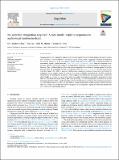No selective integration required : a race model explains responses to audiovisual motion-in-depth
Abstract
Looming motion is an ecologically salient signal that often signifies danger. In both audition and vision, humans show behavioral biases in response to perceiving looming motion, which is suggested to indicate an adaptation for survival. However, it is an open question whether such biases occur also in the combined processing of multisensory signals. Towards this aim, Cappe et al. (2009) found that responses to audiovisual signals were faster for congruent looming motion compared to receding motion or incongruent combinations. They considered this as evidence for selective integration of multisensory looming signals. To test this proposal, here, we successfully replicate the behavioral results by Cappe et al. (2009). We then show that the redundant signals effect (RSE - a speedup of multisensory compared to unisensory responses) is not distinct for congruent looming motion. Instead, as predicted by a simple probability summation rule, the RSE is primarily modulated by the looming bias in audition, which suggests that multisensory processing inherits a unisensory effect. Finally, we compare a large set of so-called race models that implement probability summation, but that allow for interference between auditory and visual processing. The best-fitting model, selected by the Akaike Information Criterion (AIC), virtually perfectly explained the RSE across conditions with interference parameters that were either constant or varied only with auditory motion. In the absence of effects jointly caused by auditory and visual motion, we conclude that selective integration is not required to explain the behavioral benefits that occur with audiovisual looming motion.
Citation
Chua , S F A , Liu , Y , Harris , J & Otto , T U 2022 , ' No selective integration required : a race model explains responses to audiovisual motion-in-depth ' , Cognition , vol. 227 , 105204 . https://doi.org/10.1016/j.cognition.2022.105204
Publication
Cognition
Status
Peer reviewed
ISSN
0010-0277Type
Journal article
Description
Funding: T.U.O. was supported by the Biotechnology and Biological Sciences Research Council (BBSRC, grant number: BB/N010108/1). S.F.A.C was partially funded by an Experimental Psychology Society Undergraduate Research Bursary.Collections
Items in the St Andrews Research Repository are protected by copyright, with all rights reserved, unless otherwise indicated.

